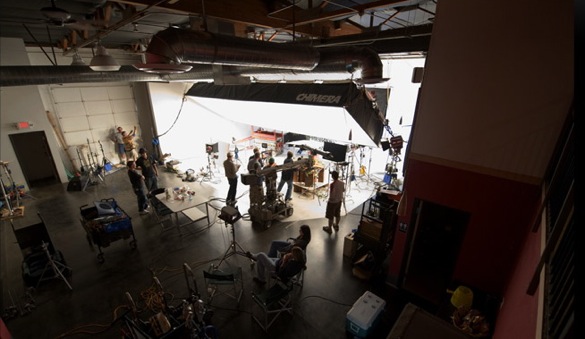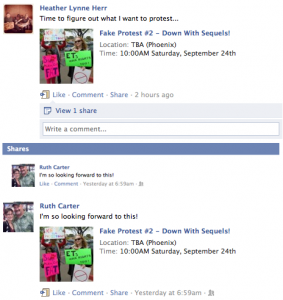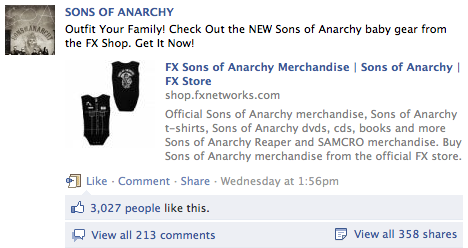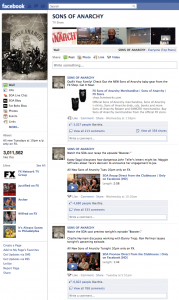Archive for category social networks
Facebook Page Engagement Numbers and Quick Competitor Comparisons
Posted by Ms. Herr in social media, social networks, socialmediatoday, the biz side on September 16, 2011
In addition to Likes and Comments, Facebook is now exposing the number of shares a post receives. This number is displayed for both individual user posts, based on that user’s privacy settings, and on Page posts.
There are definite upsides and downsides to the introduction of shares data in its current form for business and brands, who now have an additional qualitative factor on which to evaluate the engagement success of different posts. InsideFacebook has outlined a number of them. In short…
The upside:
- Alert users to the availability of the Share option and increase its usage.
- Give Page admins visibility into what and how often content is reposted (a metric we’ve previously been blind to).
- Identify who is sharing your content (think potential brand advocates).
- Push publishers to actively pursue shares.
The downside:
- Impact of shares on EdgeRank is TBD.
- Share metrics are not (or at least not yet) included in Facebook Insights.
- The repost no longer includes the name of or link back to the source (a major downside for brands).
I think initial excitement over the new shares data point overlooks the fact that some of your most important engagement numbers are right there in the open for all to see. And exposing new data points make your success, or failure, at inspiring your community to action is increasingly public.
Impressions, feedback rates, active users, demographics and daily page likes are all masked behind Insights, visible only to Page admins. The wall is good. Social media performance metrics should enjoy many of the same privacy protections that other business performance metrics do. But consider what is behind the wall, what is in front, and how this affects fan behavior and business intelligence. The exposure of Likes and Comments stands as social proof of how interesting your content is, but it also offers competitors, and the merely curious, a glimpse into how good you are at engaging your community. Now your shares are public too.
Why does this matter? After all competitors can’t see your actual engagement rates, right?
Outsiders may not be able to see your actual impressions or feedback rates, but it’s actually very easy to make an assessment as to how you are performing from an engagement standpoint. I often complete weekly competitor reviews for clients, and I can take a rough measure by comparing interactions to Page Likes. There are services that will do some of this automagically, but the following ‘by hand’ method works well for spot checks.
Add up the total number of Likes and Comments on the last 3 to 5 posts for each Page you’re reviewing (including your own). Divide that by the number of posts you looked at to get the average number of interactions per post, and then divide by the total number of Page Likes. Make sure to use the same sample size for each Page you’re looking at (e.g. last three posts for all Pages).
Interaction Rate = Average (Likes + Comments of last 3 posts) / Total Page Likes
Let’s look at Sons of Anarchy, for example:
Post 1 – 3027 Likes, 213 Comments and 358 Shares = 3598 interactions
Post 2 – 4690 Likes, 533 Comments = 5223 interactions
Post 3 – 6822 Likes, 768 Comments = 7590
Total Page Likes – 3,011,562
(Click image at right to view post data and fan count.)
Interaction Rate = ((3598 + 5223 + 7590) ÷ 3) / 3,011,562
Interaction Rate = 0.18%
Jay Baer made a great point awhile back that on Facebook, your competitive set extends beyond other companies in your industry, but all brands and businesses using Pages. You can apply the calculation above to see how any of these brands are performing.
Shares gives you, and me, and additional data point in determining how your social content is performing.
Skilled Facebook Page admins already know that some posts are better suited for generating Likes, and others comments. Ideally, your content mix includes a number of each to keep the fan experience dynamic and engaging. The introduction of shares to the visible metrics lineup will lead to new post types and strategies.
Social media pros, and your competitors, will be stalking your Page to see what works and what doesn’t.
Congratulations
Your first AWS Elastic Beanstalk Node.js application is now running on your own dedicated environment in the AWS Cloud
This environment is launched with Elastic Beanstalk Node.js Platform
What’s Next?
- AWS Elastic Beanstalk overview
- AWS Elastic Beanstalk concepts
- Deploy an Express Application to AWS Elastic Beanstalk
- Deploy an Express Application with Amazon ElastiCache to AWS Elastic Beanstalk
- Deploy a Geddy Application with Amazon ElastiCache to AWS Elastic Beanstalk
- Customizing and Configuring a Node.js Container
- Working with Logs
#snapshoot Twitter-Interactive wrap up
Posted by Ms. Herr in art stuff, blogging, events, social networks on February 24, 2009
It’s been only five days, but it still feels like yesterday that I was on set with Mark Wallace for the Twitter-Interactive photo shoot at Loft 19 Studios. It was a crazy amazing day!
Mark Wallace of SnapFactory was given the opportunity to test out the new equipment by Profoto, makers of high-end photography lighting equipment. Mark is an avid Twitterer, and conceived a live-tweeted photo shoot that allowing readers to not only follow the behind-the-scenes action, but ask questions about any aspect of the shoot, from concept to technical details. The interactive approach is such a natural fit as Mark already produces the Digital Photography 1 on 1 video series where he answers viewer-submitted questions.
Call time was 8:00am, and with only 9 hours scheduled for the shoot, all time was prime time. We had our share of challenges, from the hair, makeup, and wardrobe team getting stuck in morning traffic, to memory card failure, to the constant evaporation of time. Consider that we had four models, each with several wardrobe changes, and three sets. Add in the live uploads of behind-the-scenes photos to Flickr and the steady conversation with those following on Twitter, and you’ve got a whirlwind day.
Loft 19 was a truly amazing space to work in. The first thing that strikes you is scale. It’s a large studio offering incredible freedom for designing sets. The cyclorama is beautiful. The amenities are icing on the cake, with two lounges, ample wardrobe/hair/makeup space, and even an espresso machine which definitely got a workout while we where there.
There were so many cool parts to this project, but star of the equipment show was the Profoto Pro-8a Air which enables super fast flash cycling. The Pro-8s can generate up to 20 flashes per second. Mark shot at 10 frames per second, still incredible given typical recycle times on a flash can be up to 1 second. This clip (opens new window) only hints at the Pro-8s capability, and be sure to listen for shutter sounds as the video couldn’t capture each flash cycle.
Be sure to check out the Flickr photostream, and watch the SnapFactory blog as Mark will be posting a series of recaps about various aspects of the shoot. If you have any questions, ask. Mark is great about sharing his knowledge with others.
Many thanks to the team of people who contributed time and resources that made this event possible: Mark Wallace, Diane Wallace, and SnapFactory, Loft 19 Studios and Floyd Bannister, the models of The Agency Arizona, Erin Markis, Heather Blaine, Danno, and Jeff Caroli.
Congratulations
Your first AWS Elastic Beanstalk Node.js application is now running on your own dedicated environment in the AWS Cloud
This environment is launched with Elastic Beanstalk Node.js Platform
What’s Next?
- AWS Elastic Beanstalk overview
- AWS Elastic Beanstalk concepts
- Deploy an Express Application to AWS Elastic Beanstalk
- Deploy an Express Application with Amazon ElastiCache to AWS Elastic Beanstalk
- Deploy a Geddy Application with Amazon ElastiCache to AWS Elastic Beanstalk
- Customizing and Configuring a Node.js Container
- Working with Logs
yours truly, on the job as reporter for a Twitter-Interactive photo shoot
Posted by Ms. Herr in art stuff, blogging, events, social networks on February 18, 2009
I’ve been buzzin’ with excitement since Tuesday when I landed an awesome gig assisting Mark Wallace for an all-day Twitter-Interactive photo shoot Thursday … that’s tomorrow … where he tests out the Profoto Pro-8 Air packs.
Let me rewind and start from the beginning. I’m gonna go fast, so hold on…
I met Mark and Diane Wallace at Twestival Phoenix one week ago. I’d had a little conversation with Diane previously on Twitter, but Twestival was the first in-person meeting and the first conversation not limited to 140 characters. Over the weekend, we rectified any follows and follow-backs that were not already in effect over our many multiple accounts. Mark inquired about the #getmetosxsw project I’d just launched, and I checked out Mark’s portfolio, Diane’s portfolio, and the SnapFactory site. Mark generously offered to reach out through his connections to help me get to SXSW, and I stumbled across a blog post about a photo shoot where Mark would be live-tweeting the behind-the-scenes story of trying out some new equipment. I got a little click happy with the links, discovering Mark tried live-tweeting another photo shoot and mused it might work better if he had a reporter to tweet on his behalf. I asked to be that reporter. Mark talked it over with the team. And if haven’t figured it out by now, they brought me on board!
<insert emphatic YESSSSS!!! here>
Tomorrow morning, we’ll meet at Loft 19 Studios at 7:00am (Arizona time) for setup, model call-time, etc. The shoot will run from 9:00am-5:00pm. Mark will shoot fashion, Diane will do makeup, Erin will style wardrobe, and Danno and Jeff will shoot behind-the-scenes footage. And me? I’ll be tweeting the whole thing: the setup, the technical details, the styling, the models, the drama. I’ll be taking your questions for Mark and the team, then posting their answers.

Check out the SnapFactory blog to meet the team and meet the models. Mark tells a great story and has a wealth of prep coverage, including the model fittings.
To catch tomorrow’s live action, follow @jmarkwallace on Twitter (I’ll be tweeting as him), watch for the #snapshoot updates on Twitter Search, and most definitely tweet in with your questions and thoughts.
Congratulations
Your first AWS Elastic Beanstalk Node.js application is now running on your own dedicated environment in the AWS Cloud
This environment is launched with Elastic Beanstalk Node.js Platform
What’s Next?
- AWS Elastic Beanstalk overview
- AWS Elastic Beanstalk concepts
- Deploy an Express Application to AWS Elastic Beanstalk
- Deploy an Express Application with Amazon ElastiCache to AWS Elastic Beanstalk
- Deploy a Geddy Application with Amazon ElastiCache to AWS Elastic Beanstalk
- Customizing and Configuring a Node.js Container
- Working with Logs
two theories regarding social media, human dimensionality and community fragmentation
Posted by Ms. Herr in blogging, community, human dimensionality, social networks, socialmediatoday on January 13, 2009
Social media is at once a new and old field. Those such as Christopher Locke, his fellow authors in The Cluetrain Manifesto (website or book) and others who have been around since the internet’s inception would say the foundations were lain decades ago. Those who have entered the field in the last couple of years are still considered early adopters. Yet there are many more that have yet to realize that those giants known as MySpace, YouTube and Facebook are just the biggest in a seemingly endless stream of social media channels.
Like so many fields in fledgling states, the early adopters are in a mad rush to understand the trend, define the vernacular, explore the potential and forecast the implications. Social media is deconstructing conventional notions of relationship building, information sharing, and personal and brand engagement. The implications will be numerous, diverse and far-reaching.
Some would consider me an early adopter…
I’ve been sitting on two theories for several months. They are theories that I think few people, if any, are talking about. And they are theories the have emerged as what I’ve learned in the relatively short time I’ve been engaged in social media has subconsciously intertwined with the semblance of knowledge gathered during my years as student of architecture (UNM and ASU).
To date, I’ve done nothing to push, publish, or promote my theories, largely because I have felt a bit intimidated by the amount of research that I think will be required to adequately explore them. But time to sit no more. Time to give my thoughts public face. Time to talk less and DO more. (Thanks to @templestark for callin’ me out).
one: social media facilitates the re-piecing of human dimensionality.
Driven largely by our car-dependent culture and the specialization of industry knowledge, we have come to live very fragmented lives. We live in one place, work in a second, and play in a third. We give our time to this group and our money to that one. In each place, neighborhood, district, and organization, we associate with specific groups of people, each representing a niche, and often isolated, community. We project the parts ourselves relevant to each community’s respective cultures, operating within specific norms and talking about specific subjects. We are perceived accordingly and we are encouraged to maintain certain boundaries lest one area leak into another and compromise our standing in both.
With little crossover between our personal, professional, recreational, and hobby interests, most of the people we encounter only experience a small sliver of our personalities. Yet what makes humans so fascinating is the interweaving of likes and dislikes, strengths and weaknesses, skills and knowledge, indulgences and aspirations. These things interweave to create depth, breadth, complexity, and richness. They create dimensionality.
Social media opens the door to the fuller picture of our selves. We may still generally correspond with friends on Facebook, network with colleagues on LinkedIn or Biznik, and share ideas with people of similar passions on any number of niche interest sites, but the barriers to connecting with any one person in any number of communities are dramatically reduced. Time and distance are only nominally relevant. We’re easier to find. We’re easier to observe. We’re easier to engage. Indeed, it almost seems taboo to deny “friendship” in one community when it’s already been granted in another.
Each new request in a subsequent platform, whether online or off, flows from an interest that extends beyond the slivers of our personality toward the greater whole of our dimensionality.
two: solutions to community fragmentation will be found first in our online communities, and if they’re paying attention, urban planners and designers may be able to extrapolate the learnings for application within our physical communities
The fragmentation of our physical, neighborhood, and civic lives has long been a concern for urban planners and community developers. Whole genres, such as New Urbanism, have emerged from the search for design solutions that will help us patch the pieces back together for more cohesive lifestyles. Organizations, research efforts and books are dedicated to identifying causes and posturing solutions. There will be no one right answer, but there does not yet seem to be a satisfactory answer.
The proliferation of social media platforms is trending to a similar fragmentation of online communities. Blogs, videos, networks, bookmarks, games, podcasts and live-streams all provide means to produce, distribute and share content. Even within a single content type, there are a multitude of platforms. Consider YouTube, Viddler, Vimeo, Ustream Tv, and many more, all operating in the video space.
Early adopters jostle for beta invites from each new launch. We play with the functionality, features, user interface and mobile capabilities. We play with the other users. We love an application and become loyal users and evangelists. We hate it and they migrate back to another preferred application. Or we fall somewhere in the middle, neither passionate nor dispassionate. Over time, we collect a pocketful of applications we use frequently, as well as a vast network of friends/colleagues/associates unique to each application. We collect fragment communities.
The online world grows, adapts and evolves much faster than the physical world, so while online communities mimic that which has already undermined our physical communities, they will also find solutions much quicker. From inception to prototype to product launch, maturation times drop and results evidence sooner. The quest for solutions has already begun. Feed aggregators and application sharing are only the beginning. Urban planners and designers who take heed now will experience a virtual living lab, and the learnings will be invaluable.
Congratulations
Your first AWS Elastic Beanstalk Node.js application is now running on your own dedicated environment in the AWS Cloud
This environment is launched with Elastic Beanstalk Node.js Platform
What’s Next?
- AWS Elastic Beanstalk overview
- AWS Elastic Beanstalk concepts
- Deploy an Express Application to AWS Elastic Beanstalk
- Deploy an Express Application with Amazon ElastiCache to AWS Elastic Beanstalk
- Deploy a Geddy Application with Amazon ElastiCache to AWS Elastic Beanstalk
- Customizing and Configuring a Node.js Container
- Working with Logs
a few considerations before starting that 2nd, or 3rd, Twitter account
Posted by Ms. Herr in blogging, marketing & advertising, self-portraiture, social networks, socialmediatoday on January 6, 2009
“Who should I follow?” It’s a question every new Twitter user asks. But it’s also a question that established users continue to grapple with. As our following counts escalate, so do the challenges of keeping up with it all. The questions may shift to more narrow focuses such as follow etiquette, data quantity and filtration practices, but the root question is the same.
There is a worthwhile conversation emerging on this subject on Tomas Carrillo’s blog. I highly encourage you to read both his original post and the comment string before continuing with the rest of this post.
Tomas is leaning toward creating a second account so that he can manage his professional and personal interests separately. For many, this can appear an attractive solution.
The jump into multiple accounts is a critical step with a variety of implications. The benefits will vary depending on your goals, but there are some ramifications, for both user and reader, that are easy to overlook.
- Compartmentalizing business, personal, and niche identities as separate entities forces others who may be interested in the multiple sides of you to follow multiple streams. It’s easy to think others might only be interested in the _blank_ side of you, or that you’re only interested in the _blank_ side of others, but that’s rarely true. Being one-dimensional is usually considered a character weakness.
- Maintaining multiple accounts is likely to increase your overall time investment on Twitter. Just as you are forcing a reader interested in the multiple sides of you to read multiple streams, there will be individuals you engage both professionally and personally. On which account do you then follow them? More often than not, you’ll probably choose to follow them on each of your accounts, increasing the redundancy of your feeds.
- One account is likely to become favored, while another will become neglected. While your time invested on Twitter increases, time available in a day remains static, making it less feasible to devote equal and adequate attention to each account.
- You may undermine your brand. Whether you are a company or an individual, your brand is the unique composition that emerges from a variety of facets, from history to aspirations, from deep-seated values to social connections. As you siphon off certain facets for promotion in other channels, you risk the overall richness of the fuller brand. This risk is greater for freelancers and sole entrepreneurs. Your business is most likely an extension of yourself, and as such, your professional and personal lives are mutually reinforcing.
Using multiple Twitter accounts to separate interests is a growing trend, but in general, it’s something I would advise against. The exception may be for highly niche interests. For example, I maintain @PhxArtYC to provide updates on events at the Phoenix Art Museum. And consider Francine Hardaway who tweets as @Earth911 which is dedicated to environmental and recycling content.
Unless there is a need separate a niche interest from your personal brand, keep a single stream and show of all the different sides of you.
Congratulations
Your first AWS Elastic Beanstalk Node.js application is now running on your own dedicated environment in the AWS Cloud
This environment is launched with Elastic Beanstalk Node.js Platform
What’s Next?
- AWS Elastic Beanstalk overview
- AWS Elastic Beanstalk concepts
- Deploy an Express Application to AWS Elastic Beanstalk
- Deploy an Express Application with Amazon ElastiCache to AWS Elastic Beanstalk
- Deploy a Geddy Application with Amazon ElastiCache to AWS Elastic Beanstalk
- Customizing and Configuring a Node.js Container
- Working with Logs
What can you learn about (so-&-so) in one week?
Posted by Ms. Herr in blogging, marketing & advertising, social networks, socialmediatoday on October 31, 2008
It occasionally happens that Twitter doesn’t register tweets sent via text message until several hours later, or sometimes not at all. I’m not a fan of these type of glitches, but hey… ish happens. This evening, I had a two-tweet thought, but the first one didn’t post posted out of sequence. Perhaps it’s a blessing in disguise as now I can elaborate on my inspiration.
tweet 1: try turnin on SMS notifies for one person you follow for one week. you’ll get a great feel for who they are.
tweet 2: on for me right now: @jaybaer. really impressed by how he embraces new users & laudes lauds his contemporaries, community, & commenters.

For those who don’t know him, Jason Baer is, among many things, founder of Convince and Convert. He is a deep thinker who shares his insights and perspectives on social media and other digital marketing techniques. We’ve been loosely connected as mutual followers on Twitter for some time, but had never conversed on or offline. Until last week.
I met Jay on the final evening of the MarketingProfs Digital Marketing Mixer. I immediately turned SMS notifications on. A few hours later, Jay nearly took me out of a poker game on the first hand. Still I left notifications on. And I haven’t been disappointed.
Over 7 days and 75 tweets, I’ve seen Jay warmly greet new Twitter users, congratulate and well wish first-time bloggers, whole-heartedly promote blogs and articles he finds compelling, and graciously engage with his community both on Twitter and through his blog. I enjoyed seeing that it’s not all biz. He is engaged in his family’s lives, and he has included family into his professional life with Hottie and the Fatso. Jay talked recently about out-caring the competition, and he does.
It’s been a rewarding experience watching Jay’s character unfold via his tweets. So much so, it makes me wonder what I will learn about someone else by following all of their tweets.
Why don’t you try it? Turn on notifications for one person you follow for one week. Then come back and tell us what you’ve learned.
Congratulations
Your first AWS Elastic Beanstalk Node.js application is now running on your own dedicated environment in the AWS Cloud
This environment is launched with Elastic Beanstalk Node.js Platform
What’s Next?
- AWS Elastic Beanstalk overview
- AWS Elastic Beanstalk concepts
- Deploy an Express Application to AWS Elastic Beanstalk
- Deploy an Express Application with Amazon ElastiCache to AWS Elastic Beanstalk
- Deploy a Geddy Application with Amazon ElastiCache to AWS Elastic Beanstalk
- Customizing and Configuring a Node.js Container
- Working with Logs
building on the small wins
Posted by Ms. Herr in blogging, social networks on October 21, 2008
Yesterday I had a small win; I set a new mark for the highest number of visits to my blog, and this time it was [mostly] all me. To be clear, I’m only talking about 89 hits, which is minuscule compared to the blog gods and probably still fractional compared to the blog demigoddess’ handmaidens who at least get all the good gossip. But it’s big for me, because:
- I post less than once a week on average. Isn’t one key to traffic providing regular, and somewhat frequent content?
- It doubled my good days. Remember, I’m not an blog goddess.
- And it was a result of my own efforts.
For comparison, my previous high mark was back in June when Warren Whitlock, co-author of the Twitter Handbook, addressed the importance of selecting the right avatar and linked back to me. I’d bet the Twitter Handbook blog has high readership, so when the link generated over 85% of my 81 hits on a single day, I was ecstatic.
What makes yesterday different, is that yesterday’s traffic flowed from Twitter mostly, but also 43 Things, Gangplank hacknight, and even merciless flirt. This means the traffic was coming from my peoples, and not someone else’s.
So this begs the question, how do you measure your blogging success? Let’s temporarily exclude comments (and assume you occassionaly look at your stats) to focus on traffic. Do you care about incoming traffic? What about outbound traffic as readers explore links you provide? Is it cooler to be drive traffic by your little ol’ self, or by gaining the attention of someone bigger (for the moment at least) than you?
Congratulations
Your first AWS Elastic Beanstalk Node.js application is now running on your own dedicated environment in the AWS Cloud
This environment is launched with Elastic Beanstalk Node.js Platform
What’s Next?
- AWS Elastic Beanstalk overview
- AWS Elastic Beanstalk concepts
- Deploy an Express Application to AWS Elastic Beanstalk
- Deploy an Express Application with Amazon ElastiCache to AWS Elastic Beanstalk
- Deploy a Geddy Application with Amazon ElastiCache to AWS Elastic Beanstalk
- Customizing and Configuring a Node.js Container
- Working with Logs
my anniversary is coming…
Posted by Ms. Herr in blogging, events, social networks on September 23, 2008
It’s a little weird to think about it this way, but it’s so true. It was my first conference in the field (even though it was, in fact, an unconference). It was my introduction to real discussions about how people were participating in, and leveraging, social media. And it was an opportunity to meet Brian Shaler, a Twitter user who had thousands of followers and really amazing jump photos, and the first person I had engaged online that I didn’t first know IRL.
So on a Saturday morning in November, I woke early, dressed in comfy clothing that would help me do anything but stand out, stopped for a venti 8-pump hazelnut mocha, and made my way to what would be my first date with Phoenix’s web tech community.
I’m talking about last year’s PodCamp AZ. I had no idea what an un-conference was so I researched it online before going. I was fascinated by the law of two feet, and I followed it so well that Brent Spore, a key mastermind behind the event, said that I must have gone to every. single. session.
I was such a newb, even the moment I introduced myself to Brian was really awkward. But it was a pivotal moment for me.
It meaning PodCamp.
I learned a lot. I discovered ReadPhoenix. I listened as others talked about managing online reputations and sustaining blogs. And I met several fascinating and very smart people in Phoenix’s social media community that turned me on to other meetups where the learning continues.
We’re only six weeks out from PodCamp AZ 2.0, and I’m really excited. We started planning months ago. We’ve expanded it to two days. We’ve looked beyond social media so we can examine the relevance of all media. We’ve asked the question, “What’s your source?”
Will you be there with us as we talk about the answers?
Congratulations
Your first AWS Elastic Beanstalk Node.js application is now running on your own dedicated environment in the AWS Cloud
This environment is launched with Elastic Beanstalk Node.js Platform
What’s Next?
- AWS Elastic Beanstalk overview
- AWS Elastic Beanstalk concepts
- Deploy an Express Application to AWS Elastic Beanstalk
- Deploy an Express Application with Amazon ElastiCache to AWS Elastic Beanstalk
- Deploy a Geddy Application with Amazon ElastiCache to AWS Elastic Beanstalk
- Customizing and Configuring a Node.js Container
- Working with Logs
social media wh()re
Posted by Ms. Herr in self-portraiture, social networks on September 22, 2008
At last count, I had 33 profiles on 30 different social media related sites. I’m pretty sure I’ve forgotten a few, and I have 2 profiles on each Twitter, MySpace, and 43 Things. I’ll list and link to them all sooner or later, probably sooner as I’m about to embark on a systematic update of each and every one of them. In the meantime, here’s a very non-interactive roll call.

Congratulations
Your first AWS Elastic Beanstalk Node.js application is now running on your own dedicated environment in the AWS Cloud
This environment is launched with Elastic Beanstalk Node.js Platform
What’s Next?
- AWS Elastic Beanstalk overview
- AWS Elastic Beanstalk concepts
- Deploy an Express Application to AWS Elastic Beanstalk
- Deploy an Express Application with Amazon ElastiCache to AWS Elastic Beanstalk
- Deploy a Geddy Application with Amazon ElastiCache to AWS Elastic Beanstalk
- Customizing and Configuring a Node.js Container
- Working with Logs







